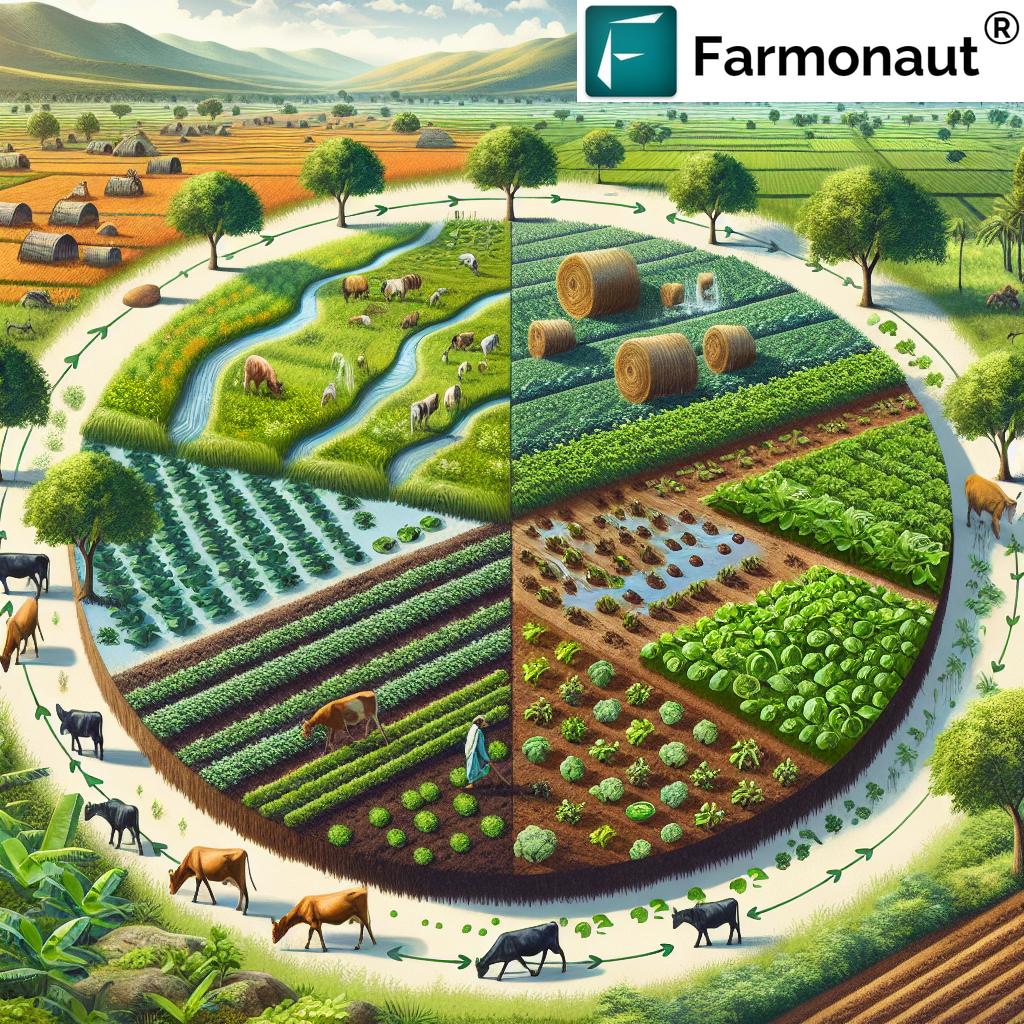Wheat Production in India: 7 Key Trends Boosting Yields
“Uttar Pradesh leads India’s wheat production, contributing over 30% to the nation’s total annual wheat output.”
Table of Contents
- 1. Historical Overview: Evolution of Wheat Production in India
- 2. Green Revolution & Technological Advancements
- 3. Current Status: Wheat Production at Record Levels
- 4. Major Wheat-Producing States in India: Trends & Yield Estimates
- 5. Best Wheat Varieties in India
- 6. Advanced Wheat Cultivation Practices
- 7. Key Challenges Facing the Indian Wheat Sector
- 8. Government Schemes & Support for Wheat Farmers
- 9. Future Prospects for Sustainable Wheat Farming in India
- 10. Farmonaut: Driving Precision and Sustainability in Wheat Farming
- 11. Frequently Asked Questions
1. Historical Overview: Evolution of Wheat Production in India
Wheat, one of the world’s most essential staple foods, has a profound history in India’s agricultural commodity landscape and food security regime. In the early 1960s, India struggled with acute food shortages—wheat production was barely enough to meet domestic needs, compelling our country to rely on imported supplies and facing serious threats to food security.
The pivotal transformation began in 1965 with increased government support and guidance from visionaries like Prime Minister Lal Bahadur Shastri and Agriculture Minister C. Subramaniam. Seeking expert insights, India’s leaders collaborated with the Rockefeller Foundation, leading to the introduction of dwarf wheat varieties from Mexico. The innovative varieties, such as Kalyan Sona and Sonalika developed with the help of Dr. Norman Borlaug, were adapted through cross-breeding to fit Indian regional conditions. This historical step established the base for our own green revolution in wheat, ensuring food security for our growing population and transforming the country into a future global producer.
“India’s wheat yield rose by 25% in the last decade due to improved varieties and modern cultivation practices.”
2. Green Revolution & Technological Advancements
The mid-20th century saw wheat production in India accelerate, especially during the green revolution in the late 1960s and 1970s. This period was characterized by massive adoption of high-yielding varieties (HYVs), as well as modernization in agricultural practices using chemical fertilizers, controlled irrigation methods, and crop protection measures.
The Indian Agricultural Research Institute (IARI) played a central role in the development and dissemination of HYVs. The green revolution sparked significant increase in yields and improvements in soil health management, elevating wheat from a scarcity crop to one of India’s most abundant food grains. This transformation enabled our nation to achieve self-sufficiency and fuel economic growth in rural regions—particularly in major wheat-producing states in India like Uttar Pradesh, Punjab, Madhya Pradesh, and Haryana.
3. Current Status: Wheat Production at Record Levels
As of 2025, India’s wheat production is at record levels. The government has estimated a production of 117.5 million metric tons for the year ending June 2025—outperforming the prior record of 113.3 million tons from 2024. This unprecedented achievement is largely due to the increased adoption of high-yield seed varieties and strategic response to favorable price incentives for wheat farmers.
With the strengthening of irrigation infrastructure and scientific crop management, Indian farmers continue to deliver high-quality wheat even under evolving climatic conditions. Our nation is now not only a secure supplier to domestic markets but also a leading exporter, making a substantial impact on the global wheat economy.
4. Major Wheat-Producing States in India: Trends & Yield Estimates
Wheat cultivation in India is highly concentrated in the northern and central regions. The top wheat-producing states—Uttar Pradesh, Madhya Pradesh, Punjab, Haryana, Bihar, Rajasthan, Gujarat, and Maharashtra—benefit from favorable soil conditions, established irrigation facilities, and innovative farming practices.
Below is a comprehensive comparison table highlighting key stats, trends, and practices in these major wheat-producing regions:
| State | Estimated Area Under Wheat (mn ha) | Estimated Production (mn tonnes) | Yield Trend | Predominant Varieties | Current Key Challenges | Notable Sustainable Practices |
|---|---|---|---|---|---|---|
| Uttar Pradesh | 9.7 | 34.8 | Increasing | Sharbati, Lok-1, PBW-343 | Water scarcity, soil fertility, heat stress | Drip irrigation, crop rotation |
| Punjab | 3.5 | 17.4 | Stable | PBW-343, HD-2967 | Groundwater depletion, pest attacks | System of Wheat Intensification (SWI), stubble management |
| Haryana | 2.6 | 11.8 | Stable | WH-1105, HD-3086 | Limited water, weed infestation | Micro-irrigation, residue mulching |
| Madhya Pradesh | 6.3 | 17.2 | Increasing | Sharbati, MP Sharbati, Lok-1 | Erratic rainfall, input costs | Rainwater harvesting, organic amendments |
| Bihar | 2.3 | 5.6 | Increasing | HD-2733, PBW-550 | Floods, post-harvest losses | Community storage, laser leveling |
| Rajasthan | 3.1 | 9.7 | Increasing | Durum, Sharbati, Lokwan | Drought, soil salinity | Drought-resistant varieties, deficit irrigation |
This table reflects both our progress and the region-specific challenges in wheat farming. While states like Uttar Pradesh and Madhya Pradesh boast expanding sown area and rising yields, others contend with water scarcity, climate adversity, and soil health issues—necessitating continued innovation.
5. Best Wheat Varieties in India: Regional Adaptation and Demand
India is renowned for cultivating a diverse range of wheat varieties tailored for unique climatic conditions, regional taste preferences, and processing needs. These locally adapted wheat strains secure a balanced supply of both premium and affordable wheat-based foods throughout the country.
- Sharbati: Esteemed for its superior taste and rich gluten content, Sharbati is primarily cultivated in Madhya Pradesh, Rajasthan, and Uttar Pradesh. This soft, aromatic variety is favored for daily bread and chapatis.
- Lokwan (Lok-1): Popular in Maharashtra and Gujarat, renowned for high protein content and perfect chapati making. Lokwan is valued by both millers and consumers.
- MP Sharbati: The pride of Madhya Pradesh, this variety combines high gluten, exceptional taste, and excellent baking/milling quality. Often sought as a premium wheat in metropolitan markets.
- Durum Wheat: Cultivated extensively in Rajasthan, this vibrant yellow variety is known for high protein and is used for pasta, semolina, and select traditional Indian dishes.
We also see continued preference for HYVs like PBW-343, HD-2967, and HD-3086 in Punjab and Haryana, which combine disease resistance with yield stability. The best wheat varieties in India are often selected based on regional soil conditions, available irrigation, consumer demand, and desired end-use (bread, semolina, pasta, etc).
6. Advanced Wheat Cultivation Practices
Wheat cultivation practices in India have evolved to maximize yield while emphasizing sustainability. Wheat is predominately a Rabi crop—sown between October and December, and harvested from March through May.
Key Practices for Enhancing Wheat Yields
- Optimal Sowing Time: Early sowing within October–November aligns with cool temperatures, leading to higher germination rates and productive tillering. Late sowing, often influenced by delayed rice harvesting, can adversely impact yields.
- Seed Treatment: Treating seeds with fungicides and biostimulants improves germination, vigor, and early pest resistance.
- Balanced Fertilization: Use of NPK and micronutrients based on soil health cards ensures nutrient balance, prevents soil degradation, and boosts productivity.
- Irrigation Management: Wheat requires at least 4–6 irrigations:
- First at CRI stage (21 days after sowing)
- Subsequent irrigations at tillering, jointing, flowering, and grain-filling stages
Modern wheat irrigation methods include canals, tube-wells, drip systems (crucial in water-scarce regions), and micro-sprinklers for efficient water use.
- Weed and Pest Management: Timely weeding with manual/mechanical methods, integrated pest management, and disease-resistant varieties are vital for minimizing losses.
- Crop Rotation: Integrating wheat with legumes and oilseeds improves soil quality, reduces disease cycles, and promotes sustainable wheat farming.
- Post-Harvest Care: Prompt and proper drying, cleaning, and storage—see post-harvest wheat storage solutions below—reduces spoilage and losses.
Soil Health Management and Balanced Fertilization
Soil health degradation is a common challenge in wheat farming. Intensive cultivation, overuse of chemical fertilizers, and monocropping can deplete vital nutrients, resulting in lower yields and reduced crop quality. Regular soil testing, organic matter incorporation, green manuring, and strict adherence to Soil Health Card recommendations can help reverse nutrient imbalances.
Post-Harvest Wheat Storage Solutions & Loss Management
Post-harvest losses can account for up to 10% of wheat output in India—posing significant threats to food security and farm income. Key solutions for post-harvest loss reduction include:
- Promotion of modern storage facilities with temperature and humidity control
- Airtight, metallic, or grain-bag storage to minimize pest/disease risk
- Improved packaging and transportation infrastructure
- Use of community warehouses and cold storage hubs
By adopting better storage management practices and minimizing post-harvest inefficiencies, we can secure higher farm incomes while stabilizing market supply.
7. Key Challenges Facing the Indian Wheat Sector
Despite our remarkable progress, wheat farming in India continues to face multi-layered challenges:
- Impact of Climate Change on Wheat Yields:
- Higher temperatures during flowering/grain filling lower output and grain quality
- Erratic rainfall and unseasonal showers increase lodging risk and promote disease outbreaks
- Frequent heatwaves have been linked to reduced yields in Punjab and Haryana
- Water Scarcity & Groundwater Depletion:
- Excessive reliance on tube wells and unchecked extraction are depleting water tables in Punjab, Haryana, and even Madhya Pradesh
- Calls for shift to sustainable wheat irrigation methods like micro-irrigation, rainwater harvesting, and soil moisture conservation
- Pest and Disease Menace:
- Rust diseases (yellow, stem, and leaf), aphid infestations continue to threaten crops
- Need for ongoing research and rapid adoption of resistant varieties
- Soil Health Degradation:
- Unbalanced fertilizer use and monocropping have caused soil fatigue and micronutrient deficiencies
- Post-Harvest Losses:
- Poor storage, lack of rural warehousing, and inefficient transport infrastructure increase wastage
- Price Volatility and Market Access:
- Price fluctuations impact farmers’ financial security and can discourage wheat cultivation
- Strengthening of farmer producer organizations (FPOs) and better access to market information helps address this
By strategically tackling these issues, we can further boost productivity and sustainability in India’s wheat sector.
To address complex challenges such as product traceability, operational efficiency, and environmental sustainability, modern wheat farming enterprises are integrating advanced AgriTech solutions.
Learn how Farmonaut’s blockchain-based traceability platform ensures transparent tracking from farm to market, benefitting both producers and consumers.
Efficient resource management is crucial amidst high input costs and logistical bottlenecks.
Discover how Farmonaut’s fleet management tools streamline agricultural logistics and reduce operational costs for agribusinesses and cooperatives.
Environmental concerns are becoming central in sustainable wheat cultivation.
Explore Farmonaut’s carbon footprinting solution to monitor and reduce the climate impact of your wheat farm operations in real time.
8. Government Schemes & Support for Wheat Farmers
Policy intervention continues to be a key pillar in supporting wheat farmers across India. Our government initiatives address price risks, crop failures, infrastructure gaps, and promote sustainable practices.
- Minimum Support Price (MSP): The MSP mechanism provides a floor price for wheat, encouraging cultivation and guaranteeing income stability for millions of smallholders.
- Pradhan Mantri Fasal Bima Yojana (PMFBY): This crop insurance scheme covers yield losses due to weather, pest, and disease shocks, thereby reducing farmers’ production risk.
- Soil Health Card Scheme: Farmers can access soil health cards with nutrient recommendations, enabling judicious use of fertilizers.
- National Food Security Mission (NFSM): Targets increased wheat production through area expansion, yield enhancement, and adoption of improved varieties.
- Pradhan Mantri Kisan Samman Nidhi (PM-KISAN): Provides direct income support to eligible farmers via cash transfer, strengthening their financial base.
- Agriculture Infrastructure Fund (AIF): Extends financial support for creation and upgradation of cold chain, post-harvest, and storage facilities—integral for minimizing post-harvest losses.
- Promotion of Farmer Producer Organizations (FPOs): Facilitates collective bargaining, market linkage, and ease of input procurement for farmers.
These government schemes for wheat farmers underpin India’s food sovereignty and promote adoption of sustainable agriculture.
Looking for satellite-based verification of crop loans and insurance?
Explore Farmonaut’s crop loan and insurance solutions for seamless, fraud-resistant financing.
9. Future Prospects for Sustainable Wheat Farming in India
Looking ahead, wheat production in India is set to scale new heights, provided we invest in sustainable farming practices, climate adaptation, and digital transformation. Here are the key trends and prospects shaping the sector’s future:
- Climate-Resilient Varieties: Leading institutes like the Indian Institute of Wheat and Barley Research (IIWBR) focus on developing drought/heat tolerant, pest/disease-resistant HYVs that can thrive in the face of climate change.
- Sustainable Water Management: Adoption of advanced wheat irrigation methods, like drip and sprinkler systems and rainwater harvesting, can conserve resources, especially in arid or semi-arid wheat growing regions.
- Digital and Precision Farming: Satellite-based monitoring, AI-driven advisory systems, and real-time crop health analytics (as provided by Farmonaut) are transforming how farms are managed—enabling data-driven decisions that maximize yields and minimize resource wastage.
- Efficient Supply Chains and Storage: Digital traceability (as seen on the Farmonaut traceability platform) and widespread adoption of modern warehouses/post-harvest wheat storage solutions reduce losses and ensure food safety.
- Policy and Institutional Support: Continued policy reform, targeted subsidies, FPO promotion, and creation of an enabling business environment for ag-tech companies and rural startups.
- Farmers’ Capacity Building: Training and extension on sustainable practices, eco-friendly crop management, and financial literacy for better income resilience.
- Environmental Sustainability: Growing emphasis on carbon footprinting and sustainable intensification to align Indian wheat with international standards on responsible agriculture.
With the right combination of scientific innovation, technology adoption, supportive policy, and farmer empowerment, India will strengthen its position as a world leader in wheat production while ensuring sustainability and security for future generations.
Start Your Precision Agriculture Journey with Farmonaut
Farmonaut makes precision farming affordable and accessible to every farmer, cooperative, and agribusiness. Choose a subscription that fits your needs and monitor your farm’s wheat health, irrigation, and sustainability metrics in real time via web, Android, or iOS.
10. Farmonaut: Driving Precision and Sustainability in Wheat Farming
As India’s wheat sector enters a data-driven era, Farmonaut stands at the forefront—empowering farmers with affordable, cutting-edge solutions.
- Satellite-Based Crop Health Monitoring: Real-time insights derived from multispectral data on wheat crop health (NDVI), soil moisture, and vegetation cover help optimize irrigation, fertilizer application, and pest management for higher wheat yields.
- Jeevn AI Advisory: Personalized advisories and weather forecasts guide farmers on every aspect of wheat cultivation—from sowing to pre-harvest operations—improving efficiency and minimizing risks.
- Blockchain-based Traceability: Every step in the wheat supply chain can be tracked, reassuring consumers and buyers of safe, high-quality, and authentic produce, essential in today’s conscious markets.
- Resource & Fleet Management: Agribusinesses and collectives benefit from smarter fleet monitoring and logistics, reducing operational costs across large wheat-growing landscapes.
- Scalability & Access: Farmonaut is available via web and mobile, ensuring ease of use for all, from smallholders to institutional players. Integration capabilities via API and developer documentation broaden the scope for digital agriculture innovation and research.
What sets Farmonaut apart is our deep understanding of the needs of Indian farmers, coupled with robust data science to ensure sustainable wheat farming at scale—meeting both today’s food security needs and tomorrow’s sustainability goals.
11. Frequently Asked Questions
How has India’s wheat production changed since the Green Revolution?
Wheat production in India has more than quadrupled since the Green Revolution, rising from chronic food shortages to self-sufficiency and current status as one of the world’s largest producers and exporters.
What are the main wheat varieties grown in India?
Key varieties include Sharbati, Lokwan (Lok-1), MP Sharbati, and Durum wheat. Regional favorites, such as PBW-343 (Punjab), HD-2967 (Haryana), and HD-2733 (Bihar), are selected for their yield, resilience, and market demand.
What challenges do Indian wheat farmers face today?
Major challenges include climate change and heat stress, water scarcity, soil health degradation, pest/disease outbreaks, price volatility, and post-harvest crop losses.
How is technology improving wheat farming in India?
Technology, especially tools like Farmonaut’s satellite crop monitoring and AI advisory, enables farmers to improve yields, manage resources better, reduce environmental footprint, and gain access to new markets through digital traceability.
What government schemes support wheat production in India?
Schemes such as MSP, PMFBY (crop insurance), NFSM (yield improvement), Soil Health Card, AIF (infrastructure), and PM-KISAN (income support) address diverse needs and risks in wheat farming.
How do sustainable wheat farming practices benefit yields?
Adopting soil-friendly agronomy, efficient water usage, crop diversity, and scientific post-harvest management builds ecosystem resilience, conserves resources, and ensures stable, high grain yields year after year.
Where can I access satellite-based crop monitoring or traceability solutions?
Satellite-based crop health, irrigation scheduling, carbon tracking, and blockchain-enabled traceability can be accessed through
Farmonaut’s web, Android, or iOS platforms.
Conclusion
Wheat production in India has transformed from a story of deficit to one of abundance and leadership in the world agricultural arena. While major wheat producing states in India—such as Uttar Pradesh, Madhya Pradesh, Punjab, and Haryana—drive much of this growth, continued advancements in cultivation practices, digital technology adoption, and government support are vital for the next decade. Embracing sustainable solutions for irrigation, soil management, post-harvest storage, and traceability will secure India’s food security, support farmers, and sustain record-breaking yields well into the future.
As we collectively innovate, adapt, and invest in the future, India will remain a beacon in wheat production—benefitting millions of farmers and global food systems alike.















